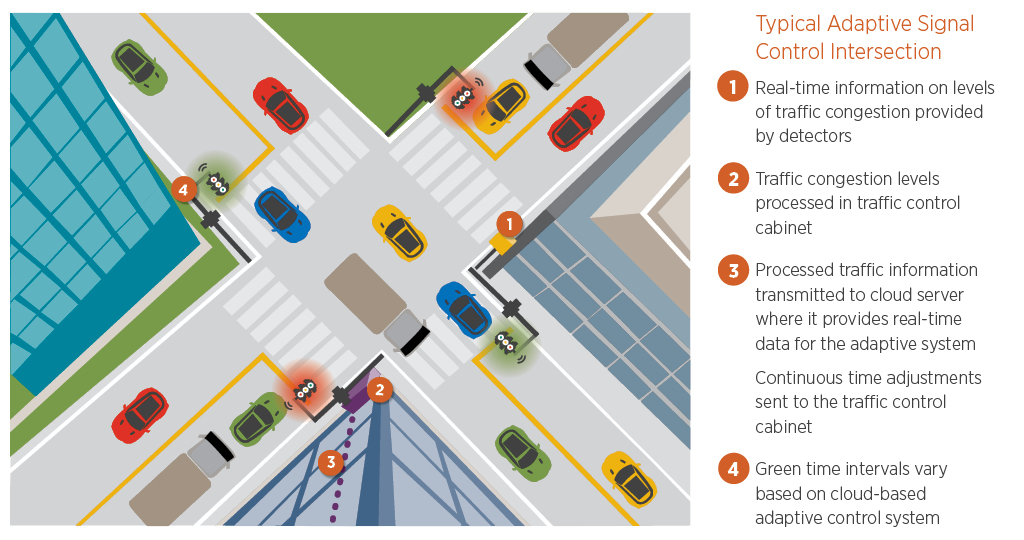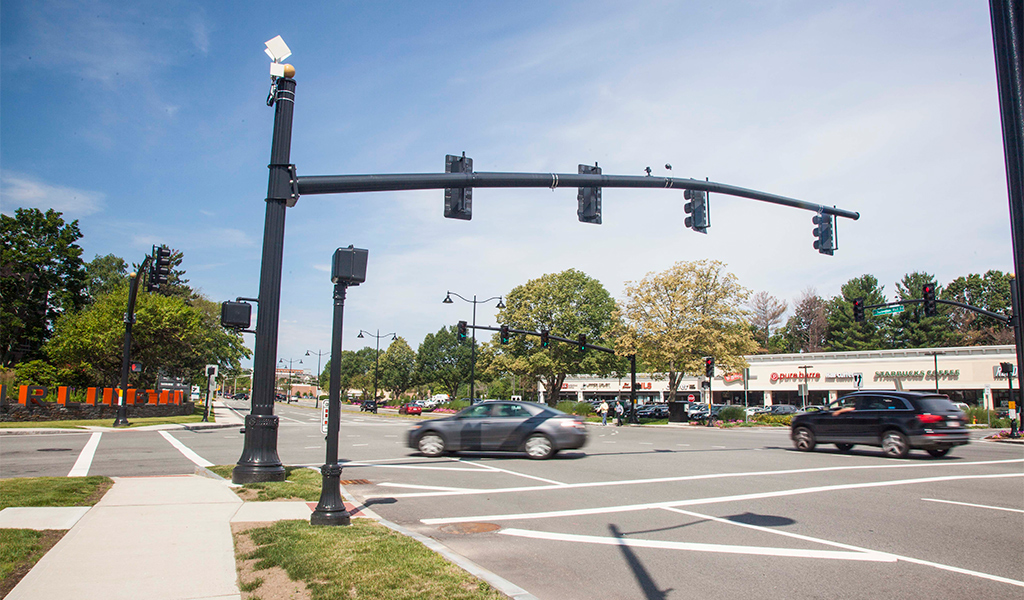As U.S. cities continue to expand and focus on smart growth strategies, adaptive signal control technology (ASCT) will become an increasingly important tool. Unlike conventional signal systems that use pre-programmed timing schedules, ASCT systems are driven by real-time data and can immediately adjust to incidents, such as accidents or congestion related to special events. This technology focuses on enhancing efficiency, improving safety, and creating a cleaner environment through less congested roadways.
As strategies and technologies evolve, the opportunities for ASCT to be integrated into comprehensive transportation solutions will continue to increase—and be key to the future of safer and smarter driving.
What Is Adaptive Signal Control Technology?
ASCT is an emerging technology that allows transportation agencies to provide safer and more efficient roads and roadway systems. This technology monitors traffic in real-time and automatically adjusts signal timings to reduce congestion and keep traffic moving. Implementing this technology will maximize existing roadway capacity, resulting in cost savings for operating agencies and system users alike. With the enhanced capabilities of adaptive systems, transit, pedestrian, and bicycle movements can be better accommodated, improving mobility for all roadway users. ASCT systems can also incorporate emerging technologies, such as automated traffic signal performance measures to enhanced artificial intelligence (AI) based vehicle detection systems, or vehicle to infrastructure (V2I) data exchange. This technology will be an important component of integrating connected and automated vehicles in the future.
How Does the Adaptive Process Work?
When successfully integrated with signal timing plans, ASCTs are able to collect and analyze data provided from roadway cameras and sensors. After these traffic sensors collect data, traffic flow patterns are evaluated, and signal timing adjustments are developed and automatically implemented by the system. This process is continuously repeated to respond to demands in real-time, enabling smooth traffic flow.

The system control algorithm provides timing adjustments based on the volume and occupancy of traffic coming from different directions. Processing data from the sensors allows for optimization and updates to signal timing settings, resulting in mobility improvements and enhanced service to the traveling public.
There are various types of adaptive systems, each utilizing different approaches on how best to optimize signal timing. While each approach produces similar benefits, they require differing levels of detection, communications, and processing capability that should be selected based on the type of roadway system to be controlled and an agency’s needs, operations, and maintenance capabilities. Since not all adaptive technologies are the same, selecting a system that is appropriate for a particular roadway requires a comprehensive understanding of both the existing operational environment and the stakeholder needs and goals for the future. A systems engineering process to methodically step through the planning, design, and operation of complex systems is often required. This process engages system stakeholders up front to identify objectives, guide the system selection, and ultimately formulate the design to provide effective solutions that address demonstrated needs.
What Are the Benefits Beyond Technological Enhancements?
Adaptive systems are an invaluable resource for transportation agencies and communities, enhancing traffic flow, efficiency, and safety. The main benefits of ASCT over conventional signal systems include:
- Increases the effectiveness of traffic signal timing and travel time reliability
- Eliminates the need to manually develop and implement coordination timing plans
- Reduces intersection congestion by recognizing changes in traffic flow and automatically adjusting the system timings to maximize efficiency and improve safety
- Maximizes existing roadway capacity, resulting in cost savings for operating agencies and system users alike
- Automatically monitors system operations so issues can be identified and mitigated by the appropriate agencies
- Responds more quickly to incidents and emergency events, recovers, and returns to typical operations
VHB is at the forefront of implementing ASCT in our neighboring cities and towns. We work with clients and vendors on a regular basis to design, evaluate, and implement this technology at a variety of sites, including:
- The Town of Burlington, Massachusetts, which experienced an increase in traffic congestion on the three major arterials carrying traffic to and from I-95 due to land use growth and compounded by outdated signal timing. The project included several ramps, I-95/Route 128 and Route 3, the Burlington Mall, Lahey Clinic, and two fire stations. The ASCT system includes wireless ethernet and fiber optics for communications, an infrared and video-based detection system, and state-of-the-practice advanced transportation controllers—all connected to the cloud for data acquisition and control. When there is a problem in Burlington, the adaptive system knows—and addresses it.
- Four locations along NH 120, including at the I-89 northbound and southbound ramps—the first ASCT system in the state. VHB partnered with the City of Lebanon and the New Hampshire Department of Transportation (NHDOT) to provide systems integration, review newly installed equipment in conjunction with the adaptive system set up, program the traffic signal controllers and adaptive databases for implementation of the adaptive system, and deploy the technology. Lebanon is a key piece of New Hampshire’s vibrant Upper Valley, and the adaptive system keeps traffic moving smoothly through its major roadways—a matter of regional importance.

- As part of an adaptive signal system initiative, a corridor in Northern Virginia was upgraded to provide new system control operations. The Virginia Department of Transportation (VDOT) called upon VHB to assist in performing a review of communications, installation, testing and field monitoring. As part of this work, VHB identified operational issues and performed troubleshooting tasks on the newly deployed system to assist VDOT with smart decision-making related to system functionality and deploying the most efficient traffic solutions.
- The Seaport District in South Boston, Boston’s fastest growing neighborhood, is a complex urban environment with recurring traffic congestion concerns. The City of Boston, Massachusetts Port Authority (Massport) and Massachusetts Department of Transportation (MassDOT) are collaborating with VHB to design and implement a 43-intersection adaptive signal control system. The Seaport is a vibrant neighborhood with regional and national conventions, large music events, a high volume of pedestrians, transit service, and frequent freight movements.
The adaptive signals will be able to respond to the demands from each of these events to relieve congestion, reduce traffic delay, improve travel times, and decrease travel time variability. - Five intersections within the Town of Framingham, Massachusetts, received improvements to address physical and operational deficiencies. Improvements included the installation of adaptive traffic signals, as well as corridor expansion for connected vehicles. As part of a larger corridor from Worcester to Route 128, this is an important regional initiative and will be the first connected vehicle corridor in Massachusetts.
How Can VHB Help
Transportation technology is constantly evolving. The challenge is understanding the unique requirements of a project and the correct technology to use for that situation and the conditions involved. Contact Niki Hastings or Joe Herr to learn more about our approach to developing and implementing an ASCT strategy that can effectively relieve congestion in your city. We regularly work with state departments of transportation and municipalities to determine what emerging technologies are right for their roadways, striving to develop a solution that creates safer and more efficient mobility for all users.





